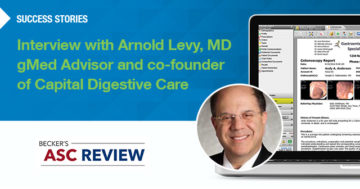How to Start and Grow a Dermatology Practice

Kick-start your team’s start-up, growth or expansion plans
Starting or expanding a dermatology practice requires careful planning and execution. In this blog, we’ll provide you with an approximate timeline to help you get organized and align with investors and other partners.
Planning may start earlier for physicians who are starting on their own for the first time. If you’re already established and are interested in expanding into new geographies or acquiring other practices, you may also be able to replicate or scale your current business practices and partnerships.
Explore these tips and insights to help you navigate the various stages of growing your business.
6 to 12 months: Secure your location and apply for licenses
When starting or expanding a medical practice, it is crucial to secure suitable locations and to apply for licenses approximately 6–12 months in advance. Securing your location prior to credentialing means you’ll have a physical address ready for all the necessary forms and paperwork.
John Gwin of the Auctus Group, a financial and operational consultant firm, adds,
“Keep in mind that if you update your address, you’ll need to update every contract with every payer. The same goes for phone numbers and so on.”
You’ll also need to purchase or lease clinical space convenient to your target patient populations. Depending on the nature of your practice, you may need specialized space beyond typical exam rooms and a front office. For example, if you offer dermatopathology services, you might require dedicated space for a laboratory. Similarly, if you provide Mohs surgery, you may need an area for histotechnology work. The equipment you need may also influence which space you choose.
During the planning phase, it is important to factor in potential construction delays. Construction projects may encounter unforeseen challenges that can push out the completion date. Be prepared for such delays and build some flexibility into your timeline.
Delays may be more likely if you have complex electrical needs. Different medical devices, such as lasers and other equipment, have varying power requirements. Your electrical outlets and wiring must be able to accommodate different loads, which may require special steps like mapping the appropriate wattage to each room.
Inspections, permits, and certificates required by local authorities are likely to be part of your construction plan, too.
Finally, when choosing a location and designing the layout of your office, consider future growth. The current location may work for you now, but will you need to start over at a new location if you continue to grow?
9 to 12 months: Start insurance credentialing
When starting a medical practice, it is crucial to initiate the insurance credentialing process nine to 12 months in advance.
Contracting with insurance companies and enrolling with Medicare and Medicaid enable you to serve patients covered by these programs. Having these contracts set up on time allows you to start billing on opening day.
Credentialing may be required by lenders or other financial partners to release the funds required to move forward.
If you’re already contracted with other insurers, carefully review your current agreements before making any changes. Look for noncompete clauses and notice periods to ensure a smooth transition. Giving yourself ample time to navigate contractual obligations may help prevent later disruptions to your practice’s operations.
Some insurers may be more important to you than others. For example, one may cover a larger number of your patients or reimburse at a high rate for certain services. However, it may not be advisable to join a new plan any time prospective patients indicate they are part of it. As John advises,
“Be sure to have a strategy. Know who the players are in your region. Understand the differences between Medicare, Medicaid and commercial plans. Think about your referral sources and which plans they take. Having a strategy is key because you cannot move quickly in the contracting/credentialing world. A proactive approach is better than a reactive one.”
The credentialing process will also require you to have your business identity ready, which may include incorporation documents, a business address, phone number and email address. It’s important that you avoid using your personal information for this step. Online records can last several months or even years, so it makes more sense to provide accurate information up front.
You may also want to consider delegated contract models through entities like management services organizations (MSOs), clinically integrated networks (CINs), physician-hospital organizations (PHOs), or accountable care organizations (ACOs). These models may allow you to maintain autonomy while benefiting from better reimbursement rates, depending on your affiliations and geography.
Take timing into account when adding providers to your practice, too. You may not be able to achieve immediate inclusion in insurance contracts after launch; each change may take up to two or three months to process. As John explains,
“Incident-to billing and locums tenans billing are not acceptable workarounds to insurers’ credentialing timelines.”
4 months: Choose integrated EHR and practice management software
Approximately four months out, you’ll want to select an electronic health record (EHR) system. You may find additional support with an all-in-one solution that offers integrated practice management (PM) software and other essential tools, like patient engagement.
Carefully plan your workflows and incorporate essential functionalities into your software:
- Implement recall functionality for recurring patients to ensure continuity of care.
- Establish streamlined revenue cycle management (RCM) for billing and payment collection.
- Enhance financial transparency with patients by leveraging estimation tools.
- Prioritize patient engagement with tools that foster communication and involvement.
Choosing an EHR specifically designed for dermatology is also key. Our software was built by dermatologists for dermatologists so that it meets your specific documentation needs and workflows. Additionally, integrating our Practice Management system with your EHR allows for seamless coordination of administrative and clinical tasks.
A variety of patient engagement solutions, ranging from autogenerated appointment reminders to feedback surveys and requests for online reviews, may be able to drive meaningful growth. These solutions can help reduce staff effort while keeping patients loyal to your dermatology practice. Their reviews may help attract new people to your practice, too.
In addition to considering your own needs, think about your team. Our dermatology EHR caters to the diverse roles within your practice, enabling smooth collaboration and easier workflows. As John explains,
“Being conservative with expenses may seem like a good idea when you’re starting out in private practice. However, your practice software is going to be your #1 go-to tool. Getting that right is almost as important as choosing the right staff and MDs. So, find somewhere else to save and pick the best tool for your practice.”
2 months: Begin advertising, marketing and promoting
Begin advertising, marketing and promoting your new dermatology practice around two months before you open.
ModMed® AMP drives your practice’s online presence so patients can find — and choose — your practice. We provide healthcare website solutions to enhance your practice’s digital footprint and design, helping you attract and maintain prospective patients’ attention and engagement.
Develop or refresh your practice’s website, including content and search engine optimization (SEO), digital advertising campaigns and social media. Create engaging blog posts and maintain an active presence on social media platforms to reach and connect with potential patients. Just keep in mind that these efforts may only rise to the level of visibility you want with paid advertising. That’s because SEO is a long-term strategy that may take six to 12 months or more to yield results.
Online reputation management can also support growth. As healthcare becomes more consumer-friendly, patients may be more likely to search for reviews when selecting a provider. Having several positive reviews over a long period of time may attract patients to your practice.
As your practice expands, you may want to incorporate upsells into patient visits. Upsells are additional or complementary services or products that patients can add to their main reason for visiting. ModMed AMP also offers an e-store option to help you sell the products your patients need directly to them.
Train your team to identify potential upselling opportunities. Track their upsells, set team goals, and provide rewards to motivate your staff. These small gestures can go a long way in fostering a positive team culture, driving sales and promoting the growth of your practice.
6 weeks: Hire and train staff
As you approach the launch of your medical practice, it’s time to start hiring and training your staff. EHR usage may comprise a large portion of your clinical staff’s daily workflow, so it’s important to make sure your team knows how to use your software.
Ahead of your first day, allocate dedicated downtime or half-days to train staff. Establish and refine financial processes with key revenue cycle team members. Determine how they’ll handle self-pay versus insurance claims. Implement a daily reconciliation process and train everyone on your bookkeeping and accounts payable processes.
When hiring mid-level providers (nonphysician practitioners), consider the impact of billing “incident to” on the mid-level’s scope of practice, clinical workflow, scheduling, payer guidelines and billing configurations. As John explains, understanding the nuances and implications of incident-to billing can help you increase practice efficiency, improve patient care, and effectively manage your revenue cycle if utilized compliantly:
“Incident-to billing can be a great way to drive revenue with mid-levels (20 points or so), but be sure to stay compliant, as it is heavily regulated and often abused.”
If applicable, strategize pathology workflows to ensure effective follow-up with patients, keeping them informed about their results and encouraging their returns for necessary appointments. Well designed pathology workflows can contribute to patient satisfaction and retention while facilitating comprehensive care within your practice.
Get started
An all-in-one software solution can provide the foundation for your daily operations, helping you shape processes and drive growth at any stage of your dermatology practice.
For more information on how ModMed can position you to impact growth and expansion at new or existing practices, request a demo.
This blog is intended for informational purposes only and does not constitute legal or medical advice. Please consult with your legal counsel and other qualified advisors to ensure compliance with applicable laws, regulations and standards.


